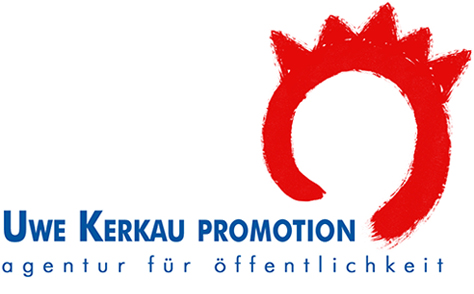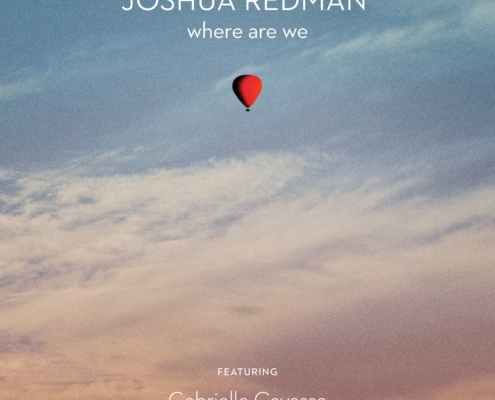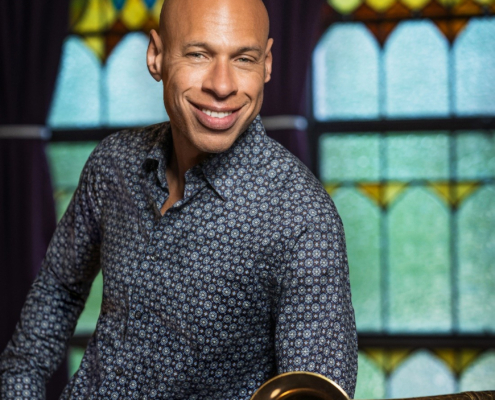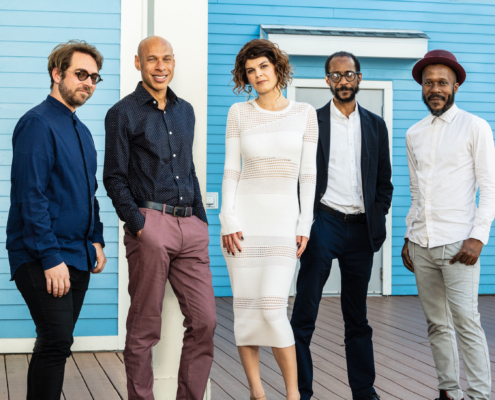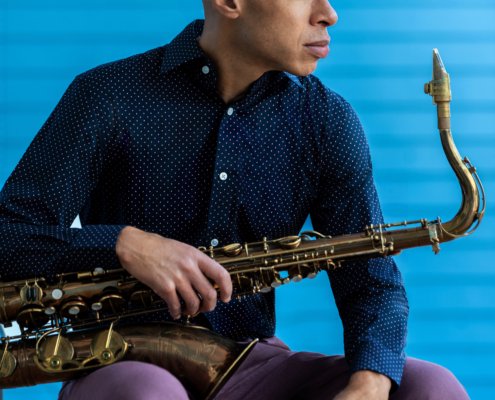Joshua Redman – where are we
-
- After Minneapolis (face toward mo[u]rning)
(Woody Guthrie/Joshua Redman) 7:44
- Streets Of Philadelphia
(Bruce Springsteen/Joshua Redman) 5:20
- Chicago Blues
(Count Basie/James Rushing/Sufjan Stevens/Joshua Redman) 4:53
- Baltimore
(Gabriel Kahane/Joshua Redman) 5:37
- By The Time I Get To Phoenix
(Jimmy Webb/ Joshua Redman) 4:41
- Do You Know What It Means To Miss
New Orleans?
(Louis Alter/Eddie De Lange/Joshua Redman) 5:05
- Manhattan
(Lorenz Hart/Richard Rodgers/Joshua Redman) 3:55
- My Heart In San Francisco (Holiday)
(George C. Cory/Douglass Cross/ Thelonious Monk/Joshua Redman) 3:13
- That’s New England
(Charles Ives/James Sinclair/Joshua Redman) 4:47
- Alabama (intro)
(John Coltrane/Joshua Redman) 0:17
- Stars Fell On Alabama
(Frank S. Perkins/Mitchell Parish/Joshua Redman) 1:55
- Alabama
(John Coltrane/Joshua Redman) 7:54
- Where Are You
(Harold Adamson/Jimmy McHugh/Joshua Redman) 5:10
Joshua Redman – Tenor Saxophone
Gabrielle Cavassa – Vocals, Aaron Parks – Piano, Joe Sanders – Bass, Brian Blade – Drums
Nicholas Payton – Trumpet, Kurt Rosenwinkel – Guitar
Peter Bernstein – Guitar, Joel Ross – Vibraphone
Der gefeierte Saxophonist Joshua Redman gibt sein Blue Note-Debüt mit „where are we“, einem überraschend stimmungsvollen Werk, das sich von Sentimentalitäten und musikalischem Weichzeichner allerdings fernhält. Die Songs mit Staaten und Städten im Titel geben sofort preis, dass es hier um Amerika geht, und um das, was das heutige Amerika für Redman und die anderen an diesem Album Beteiligten bedeutet.
Ein großer Teil des Albums besteht aus Jazz- und Pop-Standards, die zum Teil einige, zum Teil viele Jahrzehnte alt sind und bereits von unzähligen Künstlern interpretiert wurden. Obwohl Joshua Redman die Songs nah am Original hält, schafft er durch seine Interpretation immer wieder ein Gefühl des Neuentdeckens.
„where are we“ ist Joshua Redmans erstes Projekt mit durchgehender Beteiligung einer Vokalistin: Gabrielle Cavassa, einer aus Italien stammenden, in Kalifornien geborenen Sängerin, die in New Orleans lebt. Als Mitgewinnerin des wichtigen Internationalen Sarah-Vaughan-Jazz-Gesangswettbewerbs im Jahr 2021 hat sie mit ihrer geschmeidigen und intimen Stimme sowohl Publikum wie auch Kritiker überzeugt. Auf „where are we“ prägt sie den Gesamteindruck des Albums genauso wie Joshua Redman, seine Band aus Pianist Aaron Parks, Bassist Joe Sanders und Schlagzeuger Brian Blade, sowie die Special Guests Nicholas Payton an der Trompete, Kurt Rosenwinkel und Peter Bernstein an der Gitarre sowie Joel Ross am Vibraphon.
BIOGRAFIE
Seit 30 Jahren gehört der Saxophonist Joshua Redman nun schon zu den meistgeschätzten und charismatischsten Künstlern auf der internationalen Jazzszene. In diesem Zeitraum spielte er allein für seine beiden Stammlabels Warner und Nonesuch rund zwei Dutzend Alben ein, für die er insgesamt elf Grammy-Nominierungen erhielt. Nun wird Redman mit seinem neuen Album “where are we”, das im Herbst 2023 erscheinen soll, bei Blue Note ein ganz neues Kapitel aufschlagen und in für ihn ungewohnte Gefilde vorstoßen. Denn auf “where are we” wird der Saxophonist zum ersten Mal die Zusammenarbeit mit einer jungen Vokalistin in den Mittelpunkt rücken: der 26-jährigen Gabrielle Cavassa, die 2021 eine der beiden Gewinnerinnen des International Sarah Vaughan Jazz Vocal Competition war (zur Erinnerung: 2019 wurde bei dem Wettbewerb eine gewisse Samara Joy zur Siegerin gekrönt). Das Repertoire wird dabei größtenteils aus kühnen Mash-Ups von Jazzstandards, Popsongs und sogar klassischen Kompositionen bestehen. Zu Joshua Redmans Quartett (mit Pianist Aaron Parks, Bassist Joe Sanders und Drummer Brian Blade) und Cavassa stoßen als Gäste außerdem noch die Gitarristen Kurt Rosenwinkel und Peter Bernstein, Vibraphonist Joel Ross und Trompeter Nicholas Payton.
Joshua Redman wurde am 1. Februar 1969 als Sohn der Tänzerin Renee Shedroff und des Tenorsaxophonisten Dewey Redman im kalifornischen Berkley geboren. Der 2006 gestorbene Dewey Redman war u.a. durch seine Zusammenarbeit mit Ornette Coleman, die Zugehörigkeit zum amerikanischen 70er-Jahre-Quartett von Keith Jarrett und Charlie Hadens Liberation Music Orchetsra bekannt geworden. Obwohl Joshua von klein auf von Musik umgeben war und auch früh Klarinette und dann Tenorsaxophon spielen lernte, dachte er zunächst nicht daran, selbst eine professionelle Laufbahn als Musiker einzuschlagen. Stattdessen nahm er an der Harvard University ein Studium der Sozialwissenschaften auf, das er 1991mit summa cum laude abschloss, und erhielt danach einen Studienplatz an der Yale Law School. Vor Studienantritt wollte er sich jedoch noch eine einjährige “Auszeit” gönnen und zog zu Freunden nach Brooklyn in New York. Es kam, wie es kommen musste: im Nu tauchte Joshua Redman kopfüber in die Jazzszene des Big Apple ein und gewann noch im selben Jahr den Thelonious Monk International Jazz Saxophone Competition. An das wartende Studium in Yale verschwendete er schon bald keinen Gedanken mehr.
In der US-Presse wurde der damals 22-Jährige nach dem Wettbewerbsgewinn überschwänglich als einer der (stilitstisch eher konservativ augerichteten) “Young Lions” gefeiert und wechselweise mit Ikonen wie John Coltrane, Sonny Rollins oder Dexter Gordon verglichen. Auf seinem 1993 bei Warner veröffentlichten titellosen Debütalbum schien er dies zu bestätigen. Doch schon bald sollte er das Etikett des “Young Lion” abstreifen, indem er sich musikalisch immer mehr öffnete und zugleich an seinem ureigenen Profil feilte. Bereits auf dem Nachfolgealbum “Wish”, eingespielt mit den “alten Hasen” Pat Metheny, Charlie Haden und Billy Higgins, nahm er neben Standards und Eigenkompositionen auch Stücke von Stevie Wonder und Eric Clapton in sein Repertoire auf. Es folgten Alben in den unterschiedlichsten Besetzungen – darunter das Joshua Redman Quartet, Yaya3, die funkige Joshua Redman Elastic Band und die Band James Farm (gemeinsam mit Pianist Aaron Parks, Bassist Matt Penman und Drummer Eric Harland) – und eine Zusammenarbeit mit The Bad Plus. Darüber hinaus wirkte er auf zahllosen Alben anderer Künstler/innen mit oder begleitete diese auf Tourneen um die Welt. Von 2000 bis 2007 war er zudem der künstlerische Leiter von SFJAZZ und auch Mitglied des stets exzellent besetzten SFJAZZ Collective.
INFO ENGLISH
From its inception, the Blue Note label has stood for “The Finest In Jazz.” The same can be said for Joshua Redman. Over the past three decades, the saxophonist, composer, and bandleader has consistently demonstrated how to honor the music’s verities while expanding its reach in contemporary settings. On where are we, Redman’s first recording as a Blue Note artist, he delivers one of his most challenging and compelling albums to date, in a program featuring typically brilliant supporting partners and (in a first for Redman) built around a dynamic vocalist.
Redman admits that an entire project with voice had long been at the back of his mind. “Doing a record with a vocalist was something I thought I’d probably get to eventually,” he explains, laughing, “but that ‘eventually’ was starting to sound like glorified procrastination or avoidance!… Honestly, I think I was kind of torn. I’ve always had a sort of ‘rhythm section envy’ — wishing I could be more of an embedded participant in an underlying, supportive groove — but at the same time, I think in my primary role as a saxophonist in instrumental groups, I was used to being a lead voice, and I secretly didn’t want to relinquish all that melodic control! Maybe being locked down during the pandemic gave me time (too much time!) to think about all of this… I guess I decided I was ‘ready.’”
He found the perfect partner in young vocalist Gabrielle Cavassa. “I had maybe heard Gabrielle’s name from her time in the Bay Area,” Redman notes, “but I wasn’t at all familiar with her music. One night in the Fall of 2021, my manager texted me in the middle of Gabrielle’s performance at a party in New Orleans. ‘You’ve got to hear this young lady,’ she said. ‘This is not a concert, it’s a casual event, and she is just riveting.’ Once I heard Gabrielle, I realized that she has an expressive quality and an intimacy and a vulnerability in her sound that is singularly captivating.”
Having found a collaborator, Redman embarked on what proved to be a unique process. “Most of my previous recordings grew out of bands that had played and toured together consistently, and eventually developed a vibe and chemistry and repertoire to the point where we felt like we had to record. But in this case, while I had worked with each of the other instrumentalists many times before in a wide variety of settings, we hadn’t yet played all at the same time in the same group; and Gabrielle and I had literally never made a note of music together.”
The resulting program is “not really about the pandemic itself,” Redman stresses, “but the uniquely isolating conditions of that time certainly played a role in the music’s creation. The geographic flavor was probably born in part out of my own lockdown-induced wanderlust… And from a practical standpoint, Gabrielle and I basically had to plan everything virtually. (Never in my life have I talked so much art through text!) By the time I visited New Orleans to scout recording studios and finally meet her in person, we had already selected the band and picked almost all of the tunes.”
In the spirit of Woody Guthrie, Bruce Springsteen, and the other troubadours whose music comprises the program, where are we tours the U.S.A. (past, present, and perhaps even future), with shadings and alternative visions provided through mash-ups from different genres and generations. “The mash-ups were a secondary concept that first emerged while I was considering an arrangement of ‘I Left My Heart in San Francisco,’ and then Monk’s ‘San Francisco Holiday’ just sort of popped unannounced into my head,” Redman acknowledges. “When I saw that this sort of thing might work, I kept rolling with it… The San Francisco connection was just a cute little inside wink — a quick cable-car-like flourish in the middle of an otherwise slow and steady swinging ballad — but other combinations took on different trajectories.” A sliver of Charles Ives’ ‘Three Places in New England’ complements and contrasts the mood of ‘New England,’ a rare tune from a Betty Carter album; whereas the duality of ‘Stars Fell on Alabama’ and John Coltrane’s ‘Alabama’ “quite consciously juxtaposes two very different views and experiences of the American South… ‘Chicago Blues’ is sort of our present-day re-imagining of the Count Basie and Jimmy Rushing classic ‘Goin to Chicago.’ Gabrielle took some of the original stanzas and out of them fashioned her own, more personal and intimate, lyrical approach. I took melodic and harmonic motifs from Sufjan Stevens’ ‘Chicago’ and wove them into and around the blues form. I feel like what we did there was probably the most integrated, the most original, and maybe also the most successful, blending of the bunch.”
Finding musicians who fit the needs of what is fundamentally a ballads album was the relatively easy part for Redman, who has formed more memorable ensembles than can be counted on the fingers of one hand. “The musical mood is primarily slow, soft, lyrical, and romantic,” he says, “but also with darkness and longing and even sometimes anguish. I wanted musicians who were willing to embrace the beauty, the melancholy, and the mystery.” He found them in drummer Brian Blade, whose relationship with the saxophonist goes back to the beginnings of their respective careers; pianist Aaron Parks, a partner in the collective quartet James Farm; and more recent associate Joe Sanders on bass. “I was amazed that neither Aaron nor Joe had played with Brian before, but I knew they would inhabit this music together soulfully and brilliantly — sublimely and ethereally and poetically, but at the same time with a deep, earthy, visceral groove.”
For added perspective, Redman invited four other friends to contribute to the portraits of their native cities: guitarists Kurt Rosenwinkel (“Streets of Philadelphia”) and Peter Bernstein (“Manhattan”), vibraphonist Joel Ross (“Chicago Blues”), and trumpeter Nicholas Payton (“Do You Know What It Means to Miss New Orleans?”). “I’ve always been deeply suspicious of concept albums in jazz, especially when they are my own!” Redman jokes, “and there is obviously a fair amount of concept here lurking in the background. But I didn’t want it to in any way mess with the organic, spontaneous making of the music. I don’t think I ever explicitly mentioned the hometown connection aspect to anyone… I had to laugh a few days after we recorded ‘Manhattan’ when Berns called me up and said ‘Oh, ok, I get it!’”
Yet there is a concept, and it is both timely and brilliantly executed. Redman opens with an improvisation on “This Land is Your Land,” introducing his lone original, “After Minneapolis.” “That began as an instrumental composition. I actually wrote it on May 31, 2020, six days after the murder of George Floyd,” he reports. “It wasn’t till over a year-and-a-half later that I took a crack at setting it to words. I had never written lyrics before, to anything.” After a musical roadtrip in which Cavassa and the quartet evoke impressions of eight other cities and regions, the music arrives at Coltrane’s “Alabama,” surrounding the classic ballad “Stars Fell on Alabama,” another of the musical juxtapositions addressing the destruction done to lives that matter. Still, as Redman cautions, “Even though those tracks [‘After Minneapolis’ and ‘Alabama’] more or less bookend the album, they are not the entire, or necessarily even the primary, message. If anything, the music is about considering the myriad things this country is thought to be, might be, and could be. It’s about American dream, American myth, American romance, and American reality, and how they can all co-exist in combination and proximity and tension. It’s at once a celebration, an examination, and a meditation — more a set of questions or contemplations, than any sort of clear definitive statement.”
The final word is given to a composition with a more amorphous locale. “‘Where Are You?’ is one of the last songs we thought about doing,” the saxophonist recalls. “I knew that Gabrielle played some guitar, and I thought about adding a bossa nova touch… It really clicked for all of us in the studio — one of the rare times where we were all listening together in the control room on playback and were like, ‘yeah, cool, this works, it’s good, we’re done.’… It only hit me later, listening to the rough a few weeks after the session, that Gabrielle could be singing this song about America, to America; and at that moment one of the central themes of the project became clear.” What began as a formal concept allowing two unacquainted artists to organize their ideas – something that could be discarded if necessary over time – had gained a deeper significance. “This was an album whose meaning revealed itself in the making.”
where are we will leave listeners seeking to define where they, and we, are — inspired by the latest example of Joshua Redman at his finest.
Konzerte
Joshua Redman Group feat. Gabrielle Cavassa
Mo. 06.11.23 Berlin Columbia Theater
Di. 14.11.2023 München Prinzregententheater
Weitere Infos in unserem Presseportal unter
https://journalistenlounge.de – bitte dort über den Genrefilter „Jazz“ anwählen!
PR Radio
Universal Music Jazz (Deutsche Grammophon GmbH)
Stralauer Allee 1, 10245 Berlin
Blue Note Records / Universal Music
CD 0602455253002 / 2-LP 0602455253019
VÖ: 15.09.2023
Live
Joshua Redman Group feat. Gabrielle Cavassa
06.11.2023 Berlin Columbia Theater
14.11.2023 München Prinzregententheater
